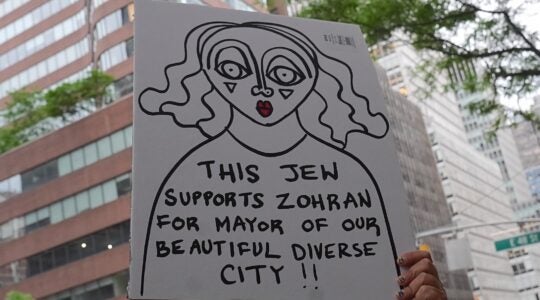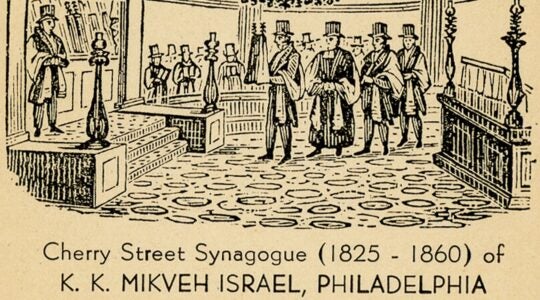NEW YORK (JTA) — All in favor of a strong Jewish future say “aye.” On that core question, there is resounding unanimity, but there have been some unnecessarily polarizing articles in the Jewish press suggesting that we have to select either endogamy or outreach.
Nonsense! Such binary thinking reduces a multi-dimensional and complex reality to a false choice.
At the Union for Reform Judaism Biennial in San Diego a few weeks back, I challenged Jewish leaders to stop speaking “about intermarriage as if it were a disease. It is not.” I do not know how any serious observer of American Jewish life can believe that in the aftermath of the Pew Research Center’s study of Jewish Americans and other surveys, intermarriage is anything but a reality of Jewish life.
Many characterize intermarriage as the result of assimilation. There is some obvious truth in this view, but I believe that higher intermarriage rates are largely the result of the open society in which we are privileged to live.
The sociology is clear enough. Anti-Semitism is down. Jews feel welcome. We mix easily with others. So, of course, there are high intermarriage rates.
The pressing question is, how do we respond? High intermarriage rates require a thoughtful response. Delivering endless sermons about the importance of endogamy — or making apocalyptic arguments — is not going to dissuade young people from falling in love with someone who is not Jewish. If that were the case, we would not be where we are today.
Intensifying and deepening Jewish engagement for the next generation is an essential undertaking that forms the cornerstone of “Inspired Engagement,” our large-scale, new URJ response. Our new youth engagement strategies reflect our broadly inclusive definition of Jewish community that seeks to include, educate and embrace, among others, children of interfaith families.
Many in the “endogamy camp” argue that outreach to interfaith families is not an effective communal investment. At the heart of this debate is the allocation of communal resources. But the impact of outreach to interfaith families — when thoughtfully and effectively deployed — matters.
Consider Boston, where Barry Shrage, president of the Combined Jewish Philanthropies, has made outreach to interfaith families a communal norm across all Jewish institutions, including synagogues. The number of interfaith families raising Jewish children has doubled.
Jews marrying Jews is a blessing; the long-term demographic projections are clearly more encouraging when Jews marry other Jews. Creating pathways for Jews and non-Jewish partners to create active Jewish homes also is a blessing, the sacred challenge of our time. However, talk of endogamy will not change outcomes. Only our actions can create change.
Going forward, the Reform movement’s singular focus is to make sure that a widening, not shrinking, circle of young people in our community experiences a Judaism that is deep, compelling and inclusive. Simultaneously, they must hear from their Jewish leaders that interfaith couples can be and are supported in their effort to raise deeply committed Jewish families, especially when they do so in an inclusive Jewish community that is offered uniquely by the Reform movement.
While other voices will surely proclaim that endogamy is the only effective way to have a committed Jewish family, the Reform movement has something altogether different to say: Jewish commitment can be established in a variety of settings, especially with support and increased opportunity for learning and engaging. Falling in love with someone who is not Jewish is not a failure of Jewish commitment at a time when young adult lives are just beginning.
How congregations and rabbis do this holy work varies, but today it is an axiom of Reform Judaism that we take on the work of inclusion every day. Some rabbis officiate at interfaith weddings; others do not. But either way, thoughtful, content-rich outreach must become the gold standard of our Jewish communities. I hope that all of our federations, inspired by Boston’s strategic shift decades ago, will soon come to that same conclusion.
Little is gained by circling the wagons only around those who are involved intensely in Jewish life and writing off the others as a bad investment. What a difference inclusion of interfaith families has made, bringing the creativity, leadership and service of hundreds of thousands to enrich our congregational lives, while countless thousands of children are being raised with meaningful Jewish experiences and commitments.
Let’s be clear: Those of us who champion outreach know, of course, that creating opportunities for young Jews to meet and form close bonds with other Jews while living Jewishly makes perfect sense. But such obvious strategies must only be one part of our ongoing work. The goal, one we all share even if we disagree on tactics, is to secure a robust Jewish future. We can only reach that goal with a real commitment to outreach.
Day schools, Jewish camps, intensive adult learning opportunities, soulful spiritual practice, acts of social justice and yes, inclusion of interfaith families in all of the above, are the most effective ways for us to strengthen the Jewish future. All opposed?
(Rabbi Rick Jacobs is the president of the Union for Reform Judaism.)
JTA has documented Jewish history in real-time for over a century. Keep our journalism strong by joining us in supporting independent, award-winning reporting.





